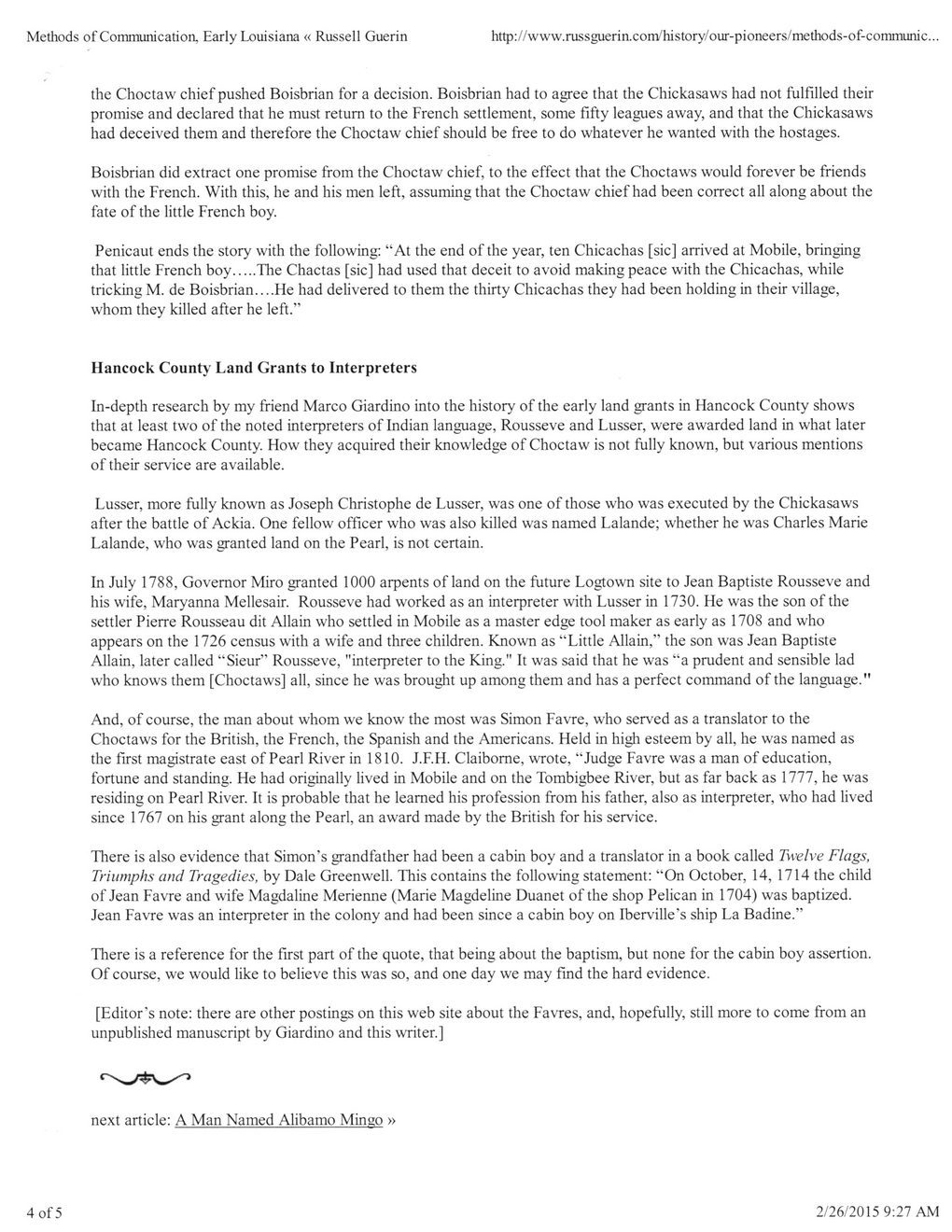This text was obtained via automated optical character recognition.
It has not been edited and may therefore contain several errors.
Methods of Communication, Early Louisiana « Russell Guerin http://www.russguerin.com/history/our-pioneers/methods-of-communic. the Choctaw chief pushed Boisbrian for a decision. Boisbrian had to agree that the Chickasaws had not fulfilled their promise and declared that he must return to the French settlement, some fifty leagues away, and that the Chickasaws had deceived them and therefore the Choctaw chief should be free to do whatever he wanted with the hostages. Boisbrian did extract one promise from the Choctaw chief, to the effect that the Choctaws would forever be friends with the French. With this, he and his men left, assuming that the Choctaw chief had been correct all along about the fate of the little French boy. Penicaut ends the story with the following: “At the end of the year, ten Chicachas [sic] arrived at Mobile, bringing that little French boy.....The Chactas [sic] had used that deceit to avoid making peace with the Chicachas, while tricking M. de Boisbrian... .He had delivered to them the thirty Chicachas they had been holding in their village, whom they killed after he left.” Hancock County Land Grants to Interpreters In-depth research by my friend Marco Giardino into the history of the early land grants in Hancock County shows that at least two of the noted interpreters of Indian language, Rousseve and Lusser, were awarded land in what later became Hancock County. How they acquired their knowledge of Choctaw is not fully known, but various mentions of their service are available. Lusser, more fully known as Joseph Christophe de Lusser, was one of those who was executed by the Chickasaws after the battle of Ackia. One fellow officer who was also killed was named Lalande; whether he was Charles Marie Lalande, who was granted land on the Pearl, is not certain. In July 1788, Governor Miro granted 1000 arpents of land on the future Logtown site to Jean Baptiste Rousseve and his wife, Maryanna Mellesair. Rousseve had worked as an interpreter with Lusser in 1730. He was the son of the settler Pierre Rousseau dit Allain who settled in Mobile as a master edge tool maker as early as 1708 and who appears on the 1726 census with a wife and three children. Known as “Little Allain,” the son was Jean Baptiste Allain, later called “Sieur” Rousseve, "interpreter to the King." It was said that he was “a prudent and sensible lad who knows them [Choctaws] all, since he was brought up among them and has a perfect command of the language." And, of course, the man about whom we know the most was Simon Favre, who served as a translator to the Choctaws for the British, the French, the Spanish and the Americans. Held in high esteem by all, he was named as the first magistrate east of Pearl River in 1810. J.F.H. Claiborne, wrote, “Judge Favre was a man of education, fortune and standing. He had originally lived in Mobile and on the Tombigbee River, but as far back as 1777, he was residing on Pearl River. It is probable that he learned his profession from his father, also as interpreter, who had lived since 1767 on his grant along the Pearl, an award made by the British for his service. There is also evidence that Simon’s grandfather had been a cabin boy and a translator in a book called Twelve Flags, Triumphs and Tragedies, by Dale Greenwell. This contains the following statement: “On October, 14, 1714 the child of Jean Favre and wife Magdaline Merienne (Marie Magdeline Duanet of the shop Pelican in 1704) was baptized. Jean Favre was an interpreter in the colony and had been since a cabin boy on Iberville’s ship La Badine.” There is a reference for the first part of the quote, that being about the baptism, but none for the cabin boy assertion. Of course, we would like to believe this was so, and one day we may find the hard evidence. [Editor’s note: there are other postings on this web site about the Favres, and, hopefully, still more to come from an unpublished manuscript by Giardino and this writer.] next article: A Man Named Alibamo Mingo » 4 of 5 2/26/2015 9:27 AM

Explorers Methods-of-Communication-With-Native-Americans---Guerin-(04)